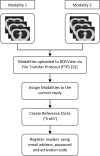ROCView: prototype software for data collection in jackknife alternative free-response receiver operating characteristic analysis
- PMID: 22573294
- PMCID: PMC3487065
- DOI: 10.1259/bjr/99497945
ROCView: prototype software for data collection in jackknife alternative free-response receiver operating characteristic analysis
Abstract
ROCView has been developed as an image display and response capture (IDRC) solution to image display and consistent recording of reader responses in relation to the free-response receiver operating characteristic paradigm. A web-based solution to IDRC for observer response studies allows observations to be completed from any location, assuming that display performance and viewing conditions are consistent with the study being completed. The simplistic functionality of the software allows observations to be completed without supervision. ROCView can display images from multiple modalities, in a randomised order if required. Following registration, observers are prompted to begin their image evaluation. All data are recorded via mouse clicks, one to localise (mark) and one to score confidence (rate) using either an ordinal or continuous rating scale. Up to nine "mark-rating" pairs can be made per image. Unmarked images are given a default score of zero. Upon completion of the study, both true-positive and false-positive reports can be downloaded and adapted for analysis. ROCView has the potential to be a useful tool in the assessment of modality performance difference for a range of imaging methods.
Figures





References
-
- Gur D, Rockette H, Bandos A. ‘Binary’ and ‘non-binary’ detection tasks: are current performance measures optimal? Acad Radiol 2007;14:871–6 - PubMed
-
- Manning D. Evaluation of diagnostic performance in radiography. Radiography 1998;4:49–60
-
- devchakraborty.com [homepage on the internet] Philadelphia: Dev Chakraborty; 2011. [updated 2011; cited 4 November 2011] Available from: http://www.devchakraborty.com/Historical%20Background.html
-
- Chakraborty D. Analysis of location specific observer performance data: validated extensions of the jackknife free-response (JAFROC) method. Acad Radiol 2006;13:1187–93 - PubMed
-
- devchakraborty.com [homepage on the internet] Philadelphia: Dev Chakraborty and Hong-Jun Yoon; 2011. JAFROC 4.0 user manual [updated 2010; cited 10 August 2011]. Available from: http://www.devchakraborty.com/Receiver%20operating%20characteristic.pdf

